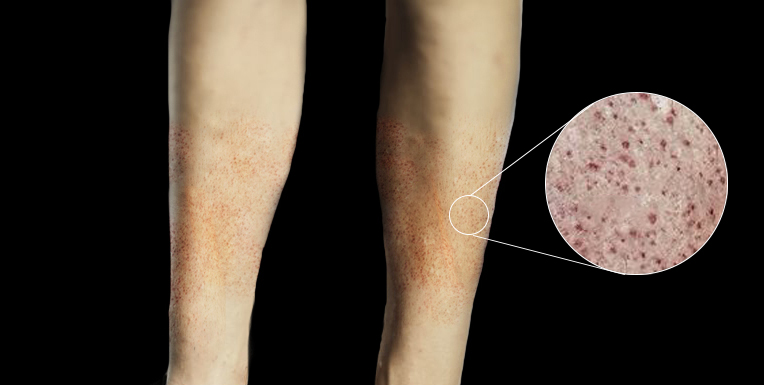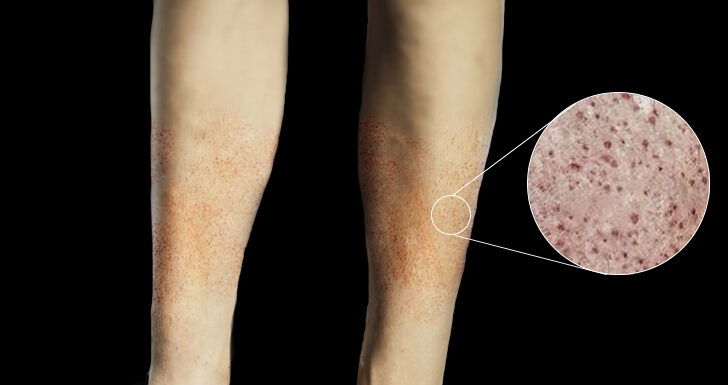What is Petechiae?
Petechiae are tiny, non-fading spots that are less than 2 mm in size, and they can appear on the skin and moist areas in the body like the mouth or nose. A non-fading or non-blanching spot is a spot that doesn’t disappear when you press down on it. When these spots are larger than 2 mm, they are referred to as purpura. Petechiae rash is often seen in children who come to the emergency department. These kinds of non-fading rashes can cause worry for both parents and doctors. As a result, it’s vital to carefully examine and evaluate these rashes to come up with a proper plan for treatment.
What Causes Petechiae?
When a child has a rash consisting of small, pinpoint, round spots called “petechiae,” there could be various causes. One serious condition to consider is Invasive meningococcal disease (IMD), caused by the bacteria Neisseria meningitidis. A child with a fever and a petechial rash needs immediate and thorough medical attention. The good news is that rates of IMD have decreased since the inclusion of meningococcal vaccines in children’s immunization schedules. Therefore, most children with a petechial rash likely have less serious conditions. However, doctors always consider IMD because of its severe health risks when assessing a child with a fever and petechiae.
The causes of a petechial rash can fall into various categories:
Infections:
– Viral: Such as Enterovirus, parvovirus B19, dengue fever
– Bacterial: Such as Meningococcal disease, scarlet fever, infective endocarditis (an infection of the inner lining of your heart)
– Rickettsial: Such as Rocky Mountain Spotted fever
– Congenital: TORCH (an acronym for a group of infections babies can get during pregnancy)
Trauma:
– Accidental injury
– Non-accidental injury
– Increased pressure from continuous bouts of coughing, vomiting, or straining
Blood and Cancer-related Conditions:
– Leukemia (cancer of the body’s blood-forming tissues)
– Idiopathic thrombocytopenic purpura (ITP, a disorder that can lead to easy or excessive bruising and bleeding)
– Thrombocytopenia with absent radius syndrome(TAR, a medical condition in which individuals have low levels of blood cells called platelets)
– Diseases related to bone marrow or blood cells such as Fanconi anemia or neonatal alloimmune thrombocytopenia(NIAT)
– Blood clot disorders, like disseminated intravascular coagulation (DIC)
– Other conditions, like hemolytic uremic syndrome (HUS, a condition that results from the destruction of red blood cells), splenomegaly(enlarged spleen)
Inflammatory and Vasculitis Conditions:
– Conditions like Henoch-Schonlein purpura (HSP, which causes inflammation and bleeding in small blood vessels) and systemic lupus erythematosus (SLE, an autoimmune disease)
Connective Tissue Disorder:
– Ehlers-Danlos syndrome (a group of disorders that affect connective tissues supporting the skin, bones, blood vessels, and many other organs and tissues).
Congenital (Present from Birth):
– Conditions such as Wiscott-Aldrich syndrome (an immune system disorder)
– Blood clotting disorders like Glanzmann thrombasthenia
– Platelet disorders like Bernard-Soulier syndrome
Other Causes:
– Drug reactions
– Vitamin K deficiency
– Chronic liver disease
Risk Factors and Frequency for Petechiae
According to one research, 2.5% of children who visit the emergency department had a petechial rash, which are small, pinpoint, red or purple spots on the body.

Signs and Symptoms of Petechiae
If your child develops petechiae, which are tiny spots on the skin caused by bleeding, you need to take them to a doctor immediately. The doctor will ask for detailed information about when the petechiae started, where they have appeared on the body, and if your child has experienced other symptoms like fever, coughing, vomiting, or any recent upper respiratory tract infection or stomach flu. They may also ask if there are any sick people around your child. Sometimes, petechiae appear more quickly in children who are unwell and have a fever, and this can be a sign of a serious infection. Additionally, a recent viral infection is common in children with certain diseases that can cause petechiae.
The doctor will also perform a thorough examination of your child, monitoring their vital signs and checking their neurological status. They’ll examine them from head to toe, especially checking their heart, lungs, abdomen, ears, nose, throat, and nerve function if needed. They’ll also pay close attention to the petechiae, possibly marking them so they can keep an eye on whether they’re spreading.
The age of your child can give the doctor clues as to what’s causing the petechiae. For example, newborns with petechiae might have certain infections or diseases, while a disease called HSP, which can cause petechiae, is more common in kids aged 2 to 5 years.
Here are some patterns of symptoms that might accompany petechiae and could indicate different diseases:
- Fever, rapid heart rate, decreased consciousness, spreading petechiae: a serious infection
- Pale skin, easy bruising, weight loss, swollen lymph nodes: cancer
- High blood pressure: kidney disease related to certain conditions
- Unusual patterns of petechiae with bruising, an inconsistent history, or signs of injury or neglect: possible child abuse
Testing for Petechiae
If your doctor suspects that you have a petechial rash, which is a rash that looks like tiny, flat purple or red spots, they might need to conduct certain tests to confirm the cause. Whichever tests they choose will depend on various factors. These factors could include where the rash is located on your body, if you have a fever, or if you show signs linked to certain diseases, such as Meningococcal Disease (IMD), Henoch-Schönlein Purpura (HSP), and Hemolytic Uremic Syndrome (HUS).
If your rash doesn’t seem to be related to a serious condition, such as being caused by an injury, and is only located above your chest, your doctor might just observe the rash over time instead of conducting tests. However, if you have a fever along with the petechial rash, it might cause your doctor to suspect IMD, even though this condition is quite rare.
For a more accurate understanding of the cause of your rash, your doctor may require you to undergo several tests.
These tests may include:
- A Complete Blood Count (CBC) test, which is done to examine the number of platelets in your blood, along with the number of white cells and the amount of hemoglobin.
- If your doctor thinks you might have IMD or a different infection, they may order tests such as the C-reactive protein test, procalcitonin test (if available), blood culture, along with tests to check your blood gases, kidney function, liver function and how well your blood clots.
- Tests to check your kidney and liver function, as well as blood clotting ability, might also be necessary in certain conditions such as Disseminated Intravascular Coagulation (DIC), IMD, HSP and HUS. When prothrombin time (the time it takes your blood to clot) is prolonged, it could indicate deficiencies in certain blood clotting factors, vitamin K deficiency or liver or kidney disease.
- If kidney-related causes are part of the possible reasons behind your symptoms, urine tests might be required to check for proteinuria (presence of excess proteins in urine), especially in conditions like HSP, HUS, and Systemic Lupus Erythematosus (SLE).
- Your doctor may also request further tests once they have a more specific idea of what might be causing your symptoms.
Your doctor’s goal with these tests is to find the cause of your rash as accurately as possible, so they can provide you with the most effective treatment.
Treatment Options for Petechiae
Many children who visit the pediatric emergency department (PED) with petechial rashes – tiny, round spots that appear on the skin due to bleeding – may not need any specific treatment. If a child remains healthy after a time of watch in the hospital, if the rash doesn’t spread, if their platelet count (which is related to clotting) is normal and if there are no signs of infection in their blood tests, they may be sent home.
However, if the doctors suspect a serious invasive bacterial infection like meningococcal disease (IMD), they would give the child antibiotics through an IV, and closely monitor the child. The child might be admitted to the regular ward or an intensive care unit based on the severity of the condition. In some cases, even before they reach the hospital, if the suspected infection is severe, the child might be given a dose of antibiotics.
If the child has specific conditions like Henoch-Schonlein Purpura (HSP), an inflammatory disease causing purple spots on the skin, or Immune thrombocytopenic purpura (ITP), a bleeding disorder, but is otherwise healthy, they may be allowed to go home. The child would be asked to return for a later appointment and would be educated about their specific condition.
In other cases, like when a drop in the number of all types of blood cells (pancytopenia) indicates the possibility of cancer, the child might need to be admitted to the hospital for treatments such as oncology (cancer) services.
What else can Petechiae be?
These are different types of skin discolorations that can occur:
- Ecchymosis: This refers to a large, flat patch of purple or blackish skin.
- Palpable purpura: This is a condition where you can feel small red or purple spots on the skin.
- Retiform purpura: This is a net-like pattern of purple or red skin discoloration.












